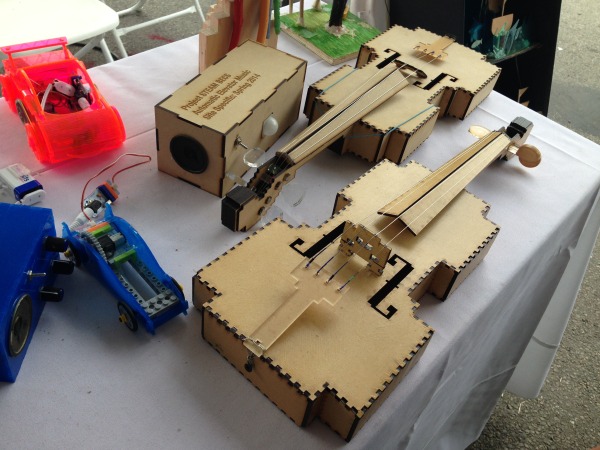This is the third in a series of blog posts about Maker Ed’s Open Portfolio Project work during the summer and fall 2014. These posts are also written in conjunction with the Research Briefs being released throughout the fall and winter of 2014.
By Anna Keune
The Marymount Fab Lab, one of four highly equipped makerspaces at Marymount School of New York, an all-girls K-12 private school, is one of 10 field sites the Open Portfolio Project core team visited as part of our efforts to learn about the portfolio and documentation practices of youth makerspaces. Technology Integrator and Fab Lab Administrator Jaymes Dec kindly agreed to an extended virtual visit through a video call with our team, telling us more about the Fab Lab, a space for open studio work for young female makers to explore, invent, and design projects based on their personal interests. Math and science classes are also occasionally held at the space. During our video call, Jaymes also gave us a tour of the space and talked to us about ongoing documentation practices.
The Marymount Fab Lab is a workshop space filled with state-of-the-art 3D printers, an embroidery machine, a laser cutter, a milling machine, electronic materials and toolkits, and a walk-in closet full of grab-and-go consumables from fabric scraps and cardboard to take-apart computers and monitors. One of the shelves in the Marymount Fab Lab is dedicated to a treasury of physics and computational gadgets, acquired by backing Kickstarter projects, for the young makers to tinker with, such as conductive ink. Beneath a workbench that spans a wall are many transparent boxes that contain glue sticks, popsicle sticks, pipe cleaners, Arduino boards, and much more. The boxes are labeled with calls for action, such as “decorate something”, “hold things together,” and “invent something.”
The Fab Lab’s vinyl cutter is actually located in the digital visualization lab of the school, a wide, open space mainly used for meetings around works-in-progress and exhibitions of past projects, expanding maker practices outside of the Fab Lab. Much of the visual documentation of the Fab Lab is also situated in the digital visualization lab. Wall-mounted screens show professional-quality photographs of past projects, and shelf space is reserved for young makers to store projects-in-progress, visible to anyone with access to the school.
In the Fab Lab, during open studio classes, Jaymes takes photographs of the young makers at work using a semi-professional SLR camera. The camera is equipped with a Wi-Fi-enabled SD card that transfers the pictures to a computer and organizes them into a folder, automating one technical aspect that might hamper documentation practices. Currently, the photographs are mainly used for external communication, but in the future it’s planned for students to have access to the folder as well.
Apart from visible documentation outside of the Fab Lab, the lab itself also includes posters of small group work, updated as projects progress. The idea is that the posters grow as the work develops, documenting students’ challenges, turning points, and decisions as they work on their projects. At the end of the school year, students will be asked to present their work (either prototypes or documentation) to a jury of upper-level students and faculty, articulating their problem statement, encountered challenges, how the challenges were addressed, and where they plan to take this work. Separate from the juried presentation, documentation is frequently used for assessment. Videos and pictures stand as proof that the students of the group really did the work, that it worked and satisfied the challenge, and that student teams collaborated.
Similar to the space, documentation practices are a work in progress for the Marymount educators. During our video call, Jaymes Dec mentioned that he would love to see every student carefully study their mistakes through documentation to become more aware of their practices and to develop a portfolio in preparation for college and professional application to set themselves apart from the masses.
As making and makerspaces — including highly-equipped spaces such as the Marymount Fab Lab — are increasing in schools, the importance of understanding how to leverage excellent portfolio practices across spaces is increasing. The virtual visit at Marymount presents excellent examples of how schools are starting to move towards making without compromising on student interests. We see that open portfolios play a role in this, for example, through shaping assessment practices and automating aspects of documentation to support smooth connections between making and portfolio creation, setting students up for academic and professional success beyond school.

